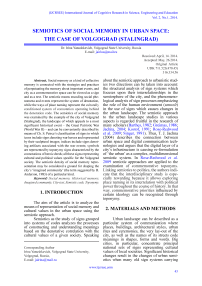Semiotics of social memory in urban space: the case of Volgograd (Stalingrad)
Автор: Irina Yanushkevich
Журнал: International Journal of Cognitive Research in Science, Engineering and Education @ijcrsee
Рубрика: Original research
Статья в выпуске: 1 vol.2, 2014 года.
Бесплатный доступ
Social memory as a kind of collective memory is connected with the strategies and practices of perpetuating the memory about important events, and city as a commemorative space can be viewed as a sign and as a text. The semiotic means encoding social phenomena and events represent the system of denotation, while the ways of place naming represent the culturally conditioned system of connotation operating behind the denotation code. The semiotics of social memory was examined by the example of the city of Volgograd (Stalingrad), the landscape of which appeals to a most significant historical event - the Great Patriotic War (World War II) - and can be conveniently described by means of Ch. S. Peirce’s classification of signs in which icons include signs denoting war heroes and represented by their sculptural images; indices include signs denoting artifacts associated with the war events; symbols are represented by toponymy signs characterized by the connotations of heroic deeds; all these signs representing cultural and political values specific for the Volgograd society. The semiotic density of social memory representation may be considered a ground for shaping the city’s ‘imagined community’ (the term suggested by B. Anderson, 1983) of a particular kind.
Social memory, historical memory, imagined community, city-text, semiotic code, toponymy
Короткий адрес: https://sciup.org/170198408
ID: 170198408


